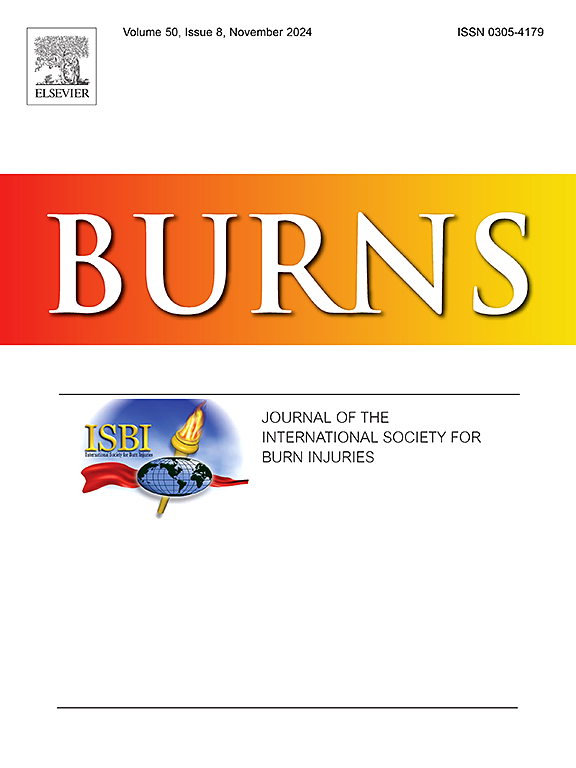BURN-OP:一种筛查工具,用于识别出院时最需要医疗护理的烧伤患者中症状明显的一组患者。
IF 2.9
3区 医学
Q2 CRITICAL CARE MEDICINE
引用次数: 0
摘要
目的根据出院症状确定需要强化康复治疗的烧伤患者:我们对烧伤模型系统国家数据库中的 1049 名成年烧伤患者进行了回顾性分析。通过无监督分层聚类,我们根据出院症状确定了三个不同的患者群组,并比较了他们的临床和人口学特征、长期康复需求以及自我报告的生活质量。我们还开发了加权烧伤康复需求--门诊病人(BURN-OP),以前瞻性地识别出康复需求最高的病人:结果:确定了三个烧伤患者群组:第一组患者症状较轻,第二组患者症状中等,第三组患者症状较重。第 3 组患者占出院患者的 6%,住院时间明显较长,烧伤时年龄较大,体表总面积较大,使用呼吸机的天数较多,手术次数较多,同时伴有吸入性损伤,从入院到出院的体重减轻较多。第 3 组患者在出院后两年内优先使用各种康复服务(包括物理治疗、职业治疗、言语病理学、社会工作、心理服务和职业服务)。他们自我报告的健康状况更差,出院后 5 年内工作/活动受到的限制更多,疼痛干扰加剧。BURN-OP 在出院时识别第 3 组患者方面表现出很高的特异性(98.99 %)和准确性(96.19 %,ROC AUC:0.93):结论:我们根据出院症状确定了不同的烧伤患者群组,其中群组 3 的出院后医疗需求最高。BURN-OP(https://burn-op.streamlit.app/)能识别高风险患者,为确定干预措施的优先顺序和设计能降低第 3 组患者风险的试验提供了工具。本文章由计算机程序翻译,如有差异,请以英文原文为准。
BURN-OP: A screening tool for identifying a symptomatically distinct cluster of burn patients with the greatest healthcare needs at discharge
Objective
To identify burn patients needing intensive rehabilitation based on discharge symptoms.
Methods
We conducted a retrospective analysis of 1049 adult burn patients recruited to the Burn Injury Model System National Database. Using unsupervised hierarchical clustering, we identified three distinct patient clusters based on discharge symptoms and compared their clinical and demographic profiles, long-term rehabilitative needs, and self-reported quality of life. We also developed a weighted BUrn Rehabilitative Needs - OutPatient (BURN-OP) to prospectively identify patients with highest rehabilitative needs.
Results
Three burn patient clusters were identified: Cluster 1 with low, Cluster 2 with moderate, and Cluster 3 with high symptom burdens. Cluster 3, comprising 6 % of discharged patients, had notably longer hospital stays, older age at burn, larger total body surface area (TBSA), increased days on ventilator, a higher number of surgical procedures, concomitant inhalation injury, and higher weight loss from admission to discharge. Cluster 3 patients preferentially utilized a wide spectrum of rehabilitative services (including physiotherapy, occupational therapy, speech-language pathology, social work, psychologic services, vocational services) extending up to 2 years post-discharge. Their self-reported health outcomes were worse, with greater limitations in work/activity and elevated pain interference persisting 5-years post-discharge. BURN-OP demonstrated high specificity (98.99 %) and accuracy (96.19 %, ROC AUC: 0.93) in identifying Cluster 3 patients at discharge.
Conclusions
We identify distinct burn patient clusters based on discharge symptoms, with Cluster 3 exhibiting the highest post-discharge healthcare needs. BURN-OP (https://burn-op.streamlit.app/) identifies high-risk patients, offering a tool for prioritizing interventions and designing trials that mitigate risk of Cluster 3 membership.
求助全文
通过发布文献求助,成功后即可免费获取论文全文。
去求助
来源期刊

Burns
医学-皮肤病学
CiteScore
4.50
自引率
18.50%
发文量
304
审稿时长
72 days
期刊介绍:
Burns aims to foster the exchange of information among all engaged in preventing and treating the effects of burns. The journal focuses on clinical, scientific and social aspects of these injuries and covers the prevention of the injury, the epidemiology of such injuries and all aspects of treatment including development of new techniques and technologies and verification of existing ones. Regular features include clinical and scientific papers, state of the art reviews and descriptions of burn-care in practice.
Topics covered by Burns include: the effects of smoke on man and animals, their tissues and cells; the responses to and treatment of patients and animals with chemical injuries to the skin; the biological and clinical effects of cold injuries; surgical techniques which are, or may be relevant to the treatment of burned patients during the acute or reconstructive phase following injury; well controlled laboratory studies of the effectiveness of anti-microbial agents on infection and new materials on scarring and healing; inflammatory responses to injury, effectiveness of related agents and other compounds used to modify the physiological and cellular responses to the injury; experimental studies of burns and the outcome of burn wound healing; regenerative medicine concerning the skin.
 求助内容:
求助内容: 应助结果提醒方式:
应助结果提醒方式:


